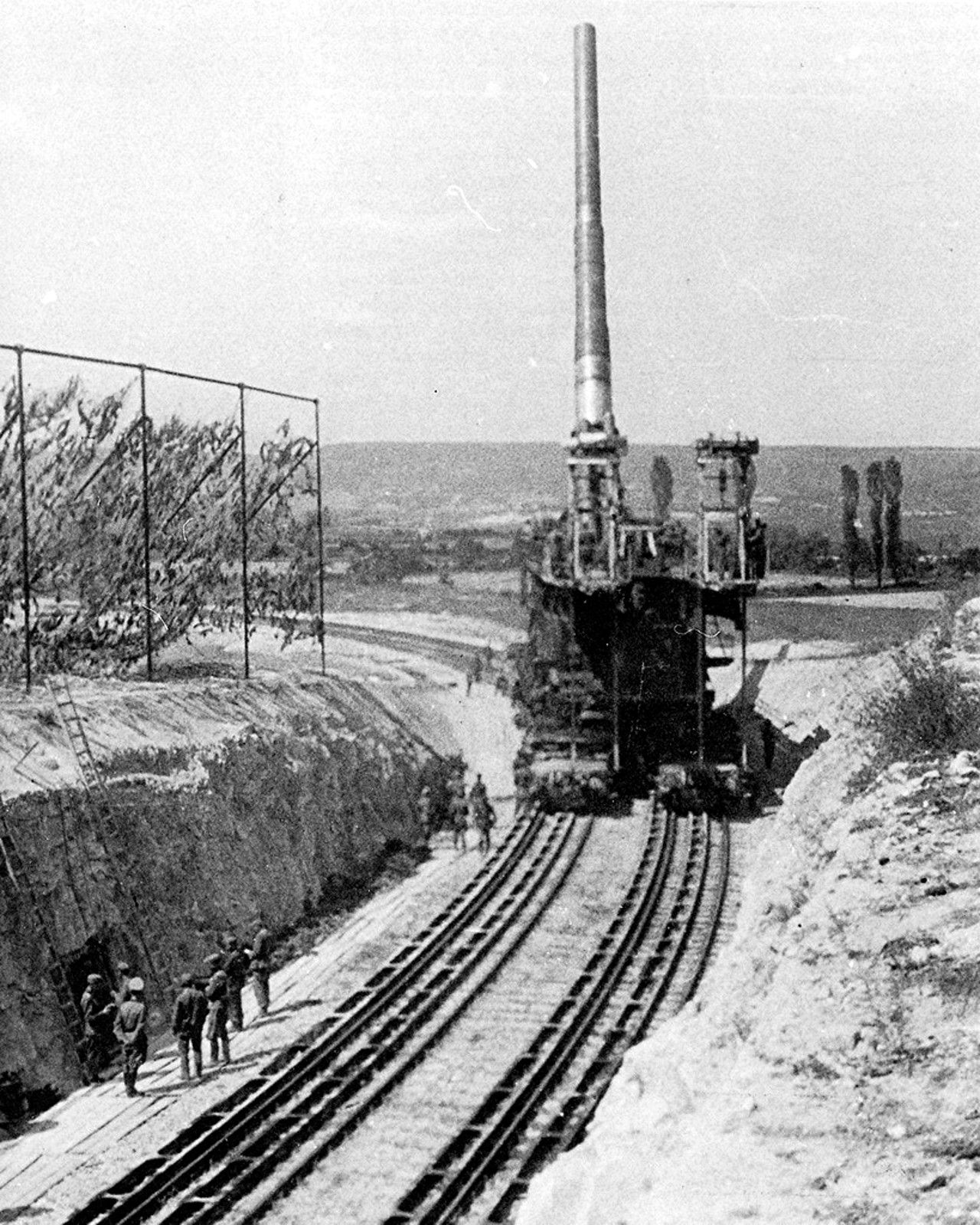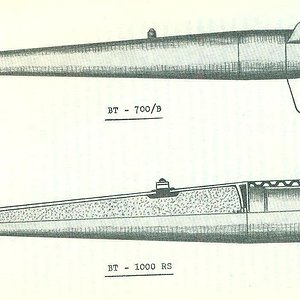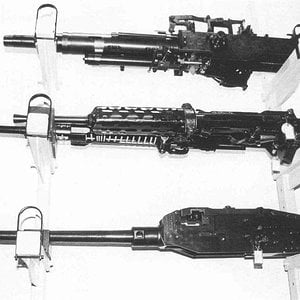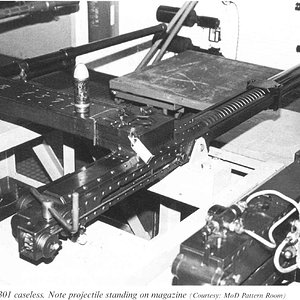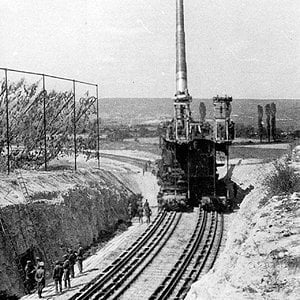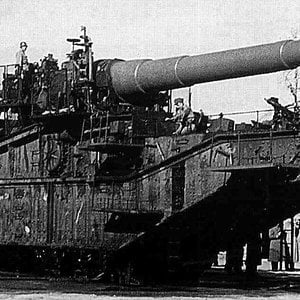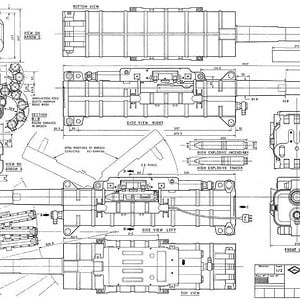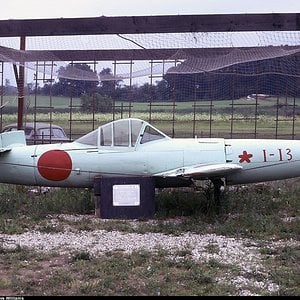Navigation
Install the app
How to install the app on iOS
Follow along with the video below to see how to install our site as a web app on your home screen.
Note: This feature may not be available in some browsers.
More options
You are using an out of date browser. It may not display this or other websites correctly.
You should upgrade or use an alternative browser.
You should upgrade or use an alternative browser.
Development
In 1934 the German Army High Command (OKH) commissioned Krupp of Essen, Germany to design a gun to destroy the forts of the French Maginot Line which were then nearing completion. The gun's shells had to punch through seven meters of reinforced concrete or one full meter of steel armour plate, from beyond the range of French artillery. Krupp engineer Erich Müller calculated that the task would require a weapon with a calibre of around 80 cm, firing a projectile weighing 7 tonnes from a barrel 30 meters long. The weapon would have a weight of over 1000 tonnes. The size and weight meant that to be at all movable it would need to be supported on twin sets of railway tracks. In common with smaller railway guns, the only barrel movement on the mount itself would be elevation, traverse being managed by moving the weapon along a curved section of railway line. Krupp prepared plans for calibres of 70 cm, 80 cm, 85 cm, and 1 m.
Nothing further happened until March 1936 when, during a visit to Essen, Adolf Hitler enquired as to the giant guns' feasibility. No definite commitment was given by Hitler, but design work began on an 80 cm model. The resulting plans were completed in early 1937 and approved. Fabrication of the first gun started in the summer of 1937. However, technical complications in the forging of such massive pieces of steel made it apparent that the original completion date of spring 1940 could not be met.
Krupp built a test model in late 1939 and sent it to the Hillersleben firing range for testing. Penetration was tested on this occasion. Firing at high elevation, the 7.1 tonne shell was able to penetrate the specified seven meters of concrete and the one meter armour plate.[3] When the tests were completed in mid-1940 the complex carriage was further developed. Alfried Krupp, after whose father the gun was named, personally hosted Hitler at the Rügenwald Proving Ground during the formal acceptance trials of the Gustav Gun in the spring of 1941. Hitler was so awestruck that he commanded that the 11-tonne[citation needed] shell could only be used at his discretion. As he never gave permission, it was never deployed.
An 800 mm shell next to a Soviet T-34-85 tank at the Imperial War Museum, London
Two guns were ordered. The first round was test-fired from the commissioned gun barrel on 10 September 1941 from a makeshift gun carriage on the Hillersleben firing range. In November 1941 the barrel was taken to Rügenwald, where 8 further firing tests were carried out using the 7,100 kilogram armor-piercing (AP) shell out to a range of 37,210 meters.
In combat, the gun was mounted on a specially designed chassis, supported by eight bogies on two parallel sets of railway tracks. Each of the bogies had 5 axles, giving a total of 40 axles (80 wheels). Krupp christened the gun Schwerer Gustav (Heavy Gustav) after the senior director of the firm, Gustav Krupp von Bohlen und Halbach.
The gun could fire a heavy concrete-piercing shell and a less heavy high-explosive shell. A super-long-range rocket projectile was also planned with a range of 150 km, that would require the barrel being extended to 84 meters.
In keeping with the tradition of the Krupp company, no payment was asked for the first gun. However, they did charge seven million Reichsmark for the second gun Dora, named after the senior engineer's wife.
Schwerer Gustav
Schwerer Gustav (black) compared to an SS-21 SRBM launcher (red) with human figures for scale.
Type
Super-Heavy Railway Gun
Place of origin
Nazi Germany
Service history
In service
1941–1945
Used by
Wehrmacht
Wars
World War II
Production history
Designer
Krupp
Designed
1934
Manufacturer
Krupp
Unit cost
7 million Reichsmark
Produced
1941
Number built
2
Specifications
Weight
1,350 tonnes (1,490 short tons; 1,330 long tons)
Length
47.3 metres (155 ft 2 in)
Barrel length
32.5 metres (106 ft 8 in) L/40.6
Width
7.1 metres (23 ft 4 in)
Height
11.6 metres (38 ft 1 in)
Crew
250 to assemble the gun in 3 days (54 hours), 2,500 to lay track and dig embankments. 2 Flak battalions to protect the gun from air attack.
Caliber
80 centimetres (31 in)
Elevation
Max of 48°
Rate of fire
1 round every 30 to 45 minutes or typically 14 rounds a day
Muzzle velocity
820 m/s (2,700 ft/s) (HE)
720 m/s (2,400 ft/s) (AP)
Effective range
about 39,000 metres (43,000 yd)
Maximum range
47,000 metres (51,000 yd) (HE)
38,000 metres (42,000 yd)
In 1934 the German Army High Command (OKH) commissioned Krupp of Essen, Germany to design a gun to destroy the forts of the French Maginot Line which were then nearing completion. The gun's shells had to punch through seven meters of reinforced concrete or one full meter of steel armour plate, from beyond the range of French artillery. Krupp engineer Erich Müller calculated that the task would require a weapon with a calibre of around 80 cm, firing a projectile weighing 7 tonnes from a barrel 30 meters long. The weapon would have a weight of over 1000 tonnes. The size and weight meant that to be at all movable it would need to be supported on twin sets of railway tracks. In common with smaller railway guns, the only barrel movement on the mount itself would be elevation, traverse being managed by moving the weapon along a curved section of railway line. Krupp prepared plans for calibres of 70 cm, 80 cm, 85 cm, and 1 m.
Nothing further happened until March 1936 when, during a visit to Essen, Adolf Hitler enquired as to the giant guns' feasibility. No definite commitment was given by Hitler, but design work began on an 80 cm model. The resulting plans were completed in early 1937 and approved. Fabrication of the first gun started in the summer of 1937. However, technical complications in the forging of such massive pieces of steel made it apparent that the original completion date of spring 1940 could not be met.
Krupp built a test model in late 1939 and sent it to the Hillersleben firing range for testing. Penetration was tested on this occasion. Firing at high elevation, the 7.1 tonne shell was able to penetrate the specified seven meters of concrete and the one meter armour plate.[3] When the tests were completed in mid-1940 the complex carriage was further developed. Alfried Krupp, after whose father the gun was named, personally hosted Hitler at the Rügenwald Proving Ground during the formal acceptance trials of the Gustav Gun in the spring of 1941. Hitler was so awestruck that he commanded that the 11-tonne[citation needed] shell could only be used at his discretion. As he never gave permission, it was never deployed.
An 800 mm shell next to a Soviet T-34-85 tank at the Imperial War Museum, London
Two guns were ordered. The first round was test-fired from the commissioned gun barrel on 10 September 1941 from a makeshift gun carriage on the Hillersleben firing range. In November 1941 the barrel was taken to Rügenwald, where 8 further firing tests were carried out using the 7,100 kilogram armor-piercing (AP) shell out to a range of 37,210 meters.
In combat, the gun was mounted on a specially designed chassis, supported by eight bogies on two parallel sets of railway tracks. Each of the bogies had 5 axles, giving a total of 40 axles (80 wheels). Krupp christened the gun Schwerer Gustav (Heavy Gustav) after the senior director of the firm, Gustav Krupp von Bohlen und Halbach.
The gun could fire a heavy concrete-piercing shell and a less heavy high-explosive shell. A super-long-range rocket projectile was also planned with a range of 150 km, that would require the barrel being extended to 84 meters.
In keeping with the tradition of the Krupp company, no payment was asked for the first gun. However, they did charge seven million Reichsmark for the second gun Dora, named after the senior engineer's wife.
Schwerer Gustav
Schwerer Gustav (black) compared to an SS-21 SRBM launcher (red) with human figures for scale.
Type
Super-Heavy Railway Gun
Place of origin
Nazi Germany
Service history
In service
1941–1945
Used by
Wehrmacht
Wars
World War II
Production history
Designer
Krupp
Designed
1934
Manufacturer
Krupp
Unit cost
7 million Reichsmark
Produced
1941
Number built
2
Specifications
Weight
1,350 tonnes (1,490 short tons; 1,330 long tons)
Length
47.3 metres (155 ft 2 in)
Barrel length
32.5 metres (106 ft 8 in) L/40.6
Width
7.1 metres (23 ft 4 in)
Height
11.6 metres (38 ft 1 in)
Crew
250 to assemble the gun in 3 days (54 hours), 2,500 to lay track and dig embankments. 2 Flak battalions to protect the gun from air attack.
Caliber
80 centimetres (31 in)
Elevation
Max of 48°
Rate of fire
1 round every 30 to 45 minutes or typically 14 rounds a day
Muzzle velocity
820 m/s (2,700 ft/s) (HE)
720 m/s (2,400 ft/s) (AP)
Effective range
about 39,000 metres (43,000 yd)
Maximum range
47,000 metres (51,000 yd) (HE)
38,000 metres (42,000 yd)

